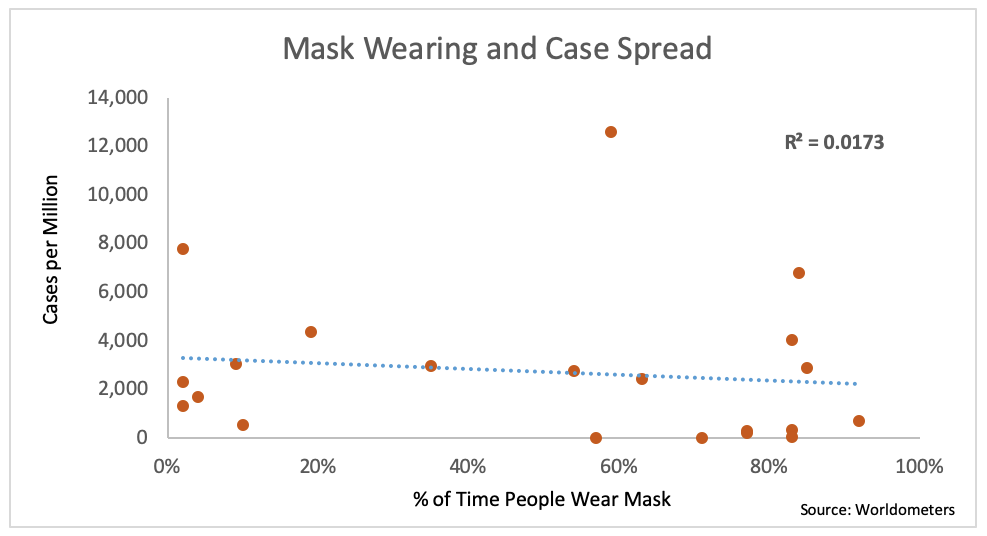Thanks to Darin Oenning for doing this work. We were curious about the relationship between mask use in various countries, as reported by the survey I posted on earlier, and cases. Here is the answer–none. Running mask use against cases per million of population shows about as low a correlation as you could have, basically zero. A country’s population wears masks a lot, it may or may not have a lot of cases. A country’s population has a low rate of mask wearing, it may or may not have a lot of cases. Yep, masks are a silver bullet into the werewolf of coronavirus. And don’t forget California, the mask mandate really worked there to prevent a surge of cases. This story points out that daily cases in the state have risen 162% since their idiot Governor imposed a mask mandate. (Cal. Story) Yep, masks will do the trick.
| Mask | Cases/Mil | |
|---|---|---|
| Phillippines | 92% | 697 |
| Mexico | 85% | 2873 |
| Spain | 84% | 6785 |
| Hong Kong | 83% | 316 |
| Italy | 83% | 4058 |
| Thailand | 83% | 47 |
| Japan | 77% | 214 |
| Malaysia | 77% | 274 |
| Vietnam | 71% | 4 |
| Germany | 63% | 2448 |
| US | 59% | 12598 |
| Taiwan | 57% | 19 |
| France | 54% | 2748 |
| Canada | 35% | 2984 |
| UK | 19% | 4376 |
| Australia | 10% | 533 |
| Netherlands | 9% | 3058 |
| Norway | 4% | 1675 |
| Denmark | 2% | 2319 |
| Finland | 2% | 1332 |
| Sweden | 2% | 7796 |



A better study would have been comparing deaths /pop, since cases is a meaningless number.
I’m really skeptical that one can tell which boat in the ocean caused which wave, if any. So many confounding variables. When there is no definitive proof that masks help and no proof that they don’t, then one has low information and adopts risk management.
Three observations from Asia about the data and conclusions. ONE: Your data reflect a STRONG correlation between mask-wearing and cases. Compare Asian countries, where mask wearing is ubiquitous and worn very early on––often even before it was considered a pandemic–– with European countries. No non-Asian countries are below 1,000 per million, while all other countries are well above 1,000 cases (except Australia, whose numbers are low because of a draconian early lockdown). TWO: The percentages for mask-wearing given are sometimes wildly inaccurate and sometimes misleading. With regard to accuracy. I live in Tokyo (former MN resident) and was floored to see data showing Taiwan LOWER than the US in mask wearing! That cannot be true. Here in Asia, we are all aware of Taiwan’s highly successful strategy in preventing the spread of the virus, which included mask-wearing––they even sent free masks to all the households weekly at the start when there was a mask shortage. https://www.ncbi.nlm.nih.gov/pmc/articles/PMC7270822/ As far as percentages that are misleading, those showing Hong Kong and Italy equivalent (83%) is perfect example. The people in Hong Kong, despite a BAN on mask-wearing that was placed on citizens who were demonstrating against China, people began to wear them very early on at a rate of 90% before they had even a dozen cases, while Italy mandated mask-wearing AFTER their lock-down, which was AFTER the virus tore through their country. Comparing apples with oranges there, to say the least. I will conclude with a note about Japan. I read elsewhere that masks obviously weren’t working because numbers were surging in Asia, including Japan. Do you want to hear what they call a surge? In Tokyo, (14 million people) the numbers “skyrocketed” to over 300 cases last week, which sent “shockwaves” through the country. These new case are primarily of unmasked, young people in crowded venues in the nightlife districts (sound familiar?) and are also a result of more testing that identified asymptomatic cases. Nevertheless, people were worried. In the States, people would be dancing in the streets with those numbers. In conclusion, while correlation is not causation, and masks certainly are not the only contributing factor in keeping numbers down, I think the numbers strongly suggest that they are beneficial. I will continue to wear my mask at appropriate times.